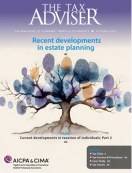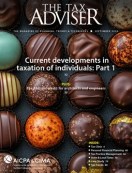Rev. Rul. 2008-18 posits two situations in which an S corporation becomes a QSub of a newly formed corporation that will qualify as an F reorganization. The ruling also provides new guidance on the proper employer identification number (EIN) to be used by the entities in each situation.
S Corporation Income Taxation
Compensation Issues for Self-Employed S Corp. Owners
This item discusses how reporting a higher wage can actually maximize long-term profits for the owner-employee of an S corporation.
IRS Offers Opportunity for 2% Shareholders of S Corp.
The IRS recently offered an opportunity for 2% shareholders of an S corporation to receive a deduction for health insurance premiums under Sec. 162(l).
Understanding the Tax Consequences of Liquidation to an S Shareholder
The shareholder consequences of a complete liquidation of an S corporation are governed by Secs. 331 and 1001. The dividend rules that otherwise apply to corporate distributions are not applicable to distributions in complete liquidation.
S Corporations’ Charitable Contributions of Appreciated Property and Shareholders’ Adjusted Basis in S Stock
PPA amended Sec. 1367(a)(2) to limit the reduction in a shareholder’s basis to the shareholder’s pro-rata share of the S corporation’s adjusted basis of the contributed property, not the FMV.
Prop. Regs. Reflect S Corporation Changes Made by AJCA and GO Zone Act
Proposed regulations provide guidance on S corporation family shareholder rules, the definitions of “powers of appointment” and “potential current beneficiaries” (PCBs) with regard to electing small business trusts (ESBTs), and the allowance of suspended losses to the spouse (or former spouse) of an S corporation shareholder.
Simplified Method Relief for Late S and Entity Classification Elections
The IRS provided an additional simplified method for certain eligible entities to request relief for late S elections and for late entity classification elections that were intended to be effective as of the intended effective date of the S election.
Preventing a Dissident Shareholder from Transferring Stock to Cause a Loss of S Status
When a corporation first elects S status, all shareholders of the corporation must consent to the election (Sec. 1362(a)(2)). However, once S status is in place, new shareholders, whether acquiring stock by purchase or gift, need not consent to the election, nor are they given the opportunity to consent.A voluntary
Current Developments in S Corporations (Part II)
This article covers S corporation operational issues.
QSubs Recognized as Separate Entities for Employment and Excise Taxes
Editor: Kevin F. Reilly, J.D., CPA The IRS has issued final regulations that treat qualified subchapter S subsidiaries (QSubs) and other disregarded entities (DEs) as separate entities for federal employment tax and certain excise tax purposes (TD 9356). Although the regulations are effective as of August 16, 2007, the employment
Modifying the Order of Distribution Rules for an S Corporation with AE&P
Editor: Joel E. Ackerman, CPA, MST A distribution from an S corporation is generally treated as made from the corporation’s accumulated adjustments account (AAA) tax free to the extent of a shareholder’s basis. It is then treated as taken from any remaining balance of AAA and is taxed at capital
Current Developments in S Corporations (Part I)
Part I of this two-part article discusses S corporation eligibility, elections, and termination issues, including several changes related to the Small Business and Work Opportunity Tax Act of 2007.
S Stock Call Options as a Second Class of Stock
Editor: Joel E. Ackerman, CPA, MST An S corporation can have only one class of stock; if a second class of stock exists, a corporation’s S election will terminate. The second-class-of-stock requirements are governed by the regulations under Sec. 1361, which states that generally call options, warrants, or similar instruments
Tracking Tax Basis in an S Corp. ESOP
Editor: Frank J. O’Connell, Jr., CPA, Esq. Employee stock ownership plans (ESOPs) currently cover 10 million employees in the U.S. participating in approximately 11,000 plans, according to the ESOP Association. With the number of plans expected to increase, the need for tax accounting and recordkeeping for ESOPs is becoming more
Open Account Debt for S Shareholders
Editor: Anthony S. Bakale, CPA, M.Tax. On April 12, 2007, the Service issued proposed amendments to Regs. Sec. 1.1367-2 and -3 (REG-144859-04), to address concerns about the treatment of S shareholders’ open account debt. Background Regs. Sec. 1.1367-2(a) states that open account debt is a shareholder advance that is not
New Law Contains Small Business Tax Provisions
On May 25, 2007, President Bush signed into law the Small Business and Work Opportunity Act of 2007 (SBWOA ’07) (P.L.110-28), which included several tax provisions. Return preparer penalties: The SBWOA ’07 expands the scope of return preparer penalties and alters the standards of conduct that must be met to
S Corporations and Disregarded Entities—Qualification as Shareholders
Executive Summary S corporations may be owned through a network of trusts, partnerships and LLCs when DEs are properly used. Letter Ruling 200439028 presents a variation on recent ownership schemes, with a layered structure involving DEs. The intertwining structure of complex ownership networks often leaves the S corporation’s eligibility status
S Holding Companies and F Reorgs.
In yet another in a series of F reorganization rulings, the IRS issued Letter Ruling 200701017, holding that the formation of a new corporation, followed by the contribution of S stock and an immediate qualified subchapter S subsidiary (QSub) election, will be treated as an F reorganization (i.e., a mere
Adjusting Basis of Inherited S Stock for IRD
Editor: Albert B. Ellentuck, Esq. Income in respect of a decedent (IRD) generally consists of items of gross income a decedent was entitled to at death that, because of the decedent’s method of accounting, were not included in the final individual return; see Regs. Sec. 1.691(a)-1(b). IRD is included in
TAX PRACTICE MANAGEMENT
2025 tax software survey
AICPA members in tax practice assess how their return preparation software performed during tax season and offer insights into their procedures.














